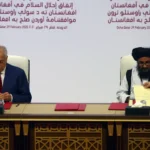The article was originally published at Modern Diplomacy
Since the 1970s, Afghanistan has remained a land of unending turmoil due to global geopolitical rivalries and deep internal social fault lines. Over the decades, successive international interventions, from Cold War rivalries to post-9/11 counterterrorism efforts, have sought to stabilize the country, eliminate militancy, and bring it to the brink of peace and prosperity. However, this has remained an unfulfilled aspiration, as Afghanistan has instead been trapped in persistent cycle of chaos and uncertainty.
Today, the country’s soil continues to serve as a battleground for insurgent movements that threaten not only Afghanistan’s internal cohesion but also the security of the broader region. Despite repeated assurances by Afghan authorities including the Taliban that their territory would not be used to harbor or launch terrorist activities, these pledges have largely failed in practice. The Taliban’s written and verbal commitments, including the 2020 Doha Accord with the US and later agreements with the UAE and Turkiye, were formed to facilitate intra-Afghan dialogue and curtail cross-border insurgency. However, these were not materialized by Afghan Taliban and terrorist’s hideouts still exist in the country. The lack of credible Afghan political process has also raised concerned over Taliban’s trustworthiness as a security ally in future.
Taliban Deception and the Collapse of Intra-Afghan Dialogue
Nonetheless, the Taliban continue to deceive and a persistent unwillingness to keep their promises. They extracted large concessions after the signing of the 2020 Doha Agreement which included among other things recognition as a legitimate international actor, release of prisoners, and provision of financial assistance. The Taliban did not hold on their commitment to the deal. The first phase of the agreement clearly required the Taliban to take part in intra-Afghan talks directed at reaching a political solution to the conflict in the country. As a step in this process, the US and the Afghan government agreed to free 5,000 Taliban prisoners with the condition of strong guarantees that they would not renounce violence and not return to the fighting. However, the opposite happened; most of those released quickly returned to the militant ranks, thereby increasing the Taliban’s offensive. Rather than talking with the then-Afghan government of Ashraf Ghani, the Taliban escalated their insurgency which finally led to their forceful takeover of Kabul in August 2021, an event which clearly demonstrated the weakness of international diplomacy and the Taliban’s deceit in the peace process.
Afghan Soil: Terrorism’s Safe Haven
According to the second part of the 2020 Doha Agreement between the United States and the Taliban, the latter had to stop individuals or groups from using Afghan territory who were posing political threats to other countries; an obligation that has been broken over time and again. Reliable international and independent sources have confirmed that the territory of Afghanistan has once again turned into haven for international terrorist groups. In August 2022, just a year after the Taliban’s return to power, Al-Qaeda leader Ayman al-Zawahiri was killed in a US drone strike in central Kabul; a stark indication that the Taliban were sheltering senior extremist figures despite their pledges to the contrary. Sarah Adams, a former CIA Al-Qaeda case officer based in Kabul, has repeatedly affirmed that Saif al-Adl, Zawahiri’s successor, along with Hamza bin Laden, continues to reside in Kabul under the protection of the Taliban regime.
The 35th Report of the UN Monitoring Team (February 2025) further underscored Saif al-Adl’s strategy to reorganize Al-Qaeda’s operational network in Afghanistan and to reactivate sleeper cells in Iraq, Libya, and Europe; a development that poses a direct threat to regional and international security. Subsequently, the 36th UN Monitoring Report (2025) went even further, outlining the Taliban regime’s active support for both Tehrik-i-Taliban Pakistan (TTP) and Al-Qaeda. It confirmed that the Taliban’s General Directorate of Intelligence (GDI) had provided three guesthouses in Kabul for TTP leaders, issued them movement passes and weapon permits, and granted them complete immunity from arrest.
Moreover, the findings from the 66th Quarterly Report of the Special Inspector General for Afghanistan Reconstruction (SIGAR) released in January 2025, cited UN estimates of 6,000-6,500 TTP fighters operating from Afghan territory, in addition to at least 12 senior Al-Qaeda leaders. The report further stated that the TTP militants operating from Afghanistan had launched cross-border attacks which lead to the death of 16 security personnel in Pakistan’s South Waziristan District. The 68th SIGAR report released in July 2025, pointed out the same issue that the Taliban were giving shelter to ISIS-Khorasan, Al-Qaeda, and TTP fighters collectively undermining the regional peace and stability.
Domestic Repression and Human Rights Violations
Beyond the security domain, the Taliban’s behavior within the country are a perfect example of repression and total neglect of international norms. United Nation Assistance Mission in Afghanistan (UNAMA) Media freedom report highlighted that a total of 256 cases of journalists and media personnel being taken into custody without legal basis, 130 cases of torture, and 75 cases of threats/intimidation were reported. The numbers show not only the Taliban’s violation of international obligations but also their deep-rooted hostility towards freedom of expression and human rights, which in turn contributes to the view that Afghanistan ruled by the Taliban is still a center of militant extremism and systemic abuse.
Trilateral Agreement with Pakistan and UAE: Failures in Implementation
In 2024, following extensive dialogue between Pakistan, the United Arab Emirates, and the Afghan Taliban, a trilateral agreement was reached with the objective of curbing cross-border militancy. The Taliban, under the terms of the deal, promised to move Tehrik-i-Taliban Pakistan (TTP) fighters from the areas near the Afghanistan-Pakistan border and to prevent their crossing into Pakistani territory. In return, the Taliban received a financial assistance from the UAE to facilitate the relocation process and associated reintegration measures. Nevertheless, the actual execution was again to a great extent less than the promises. It was only a few hundred militants that were claimed to be moved, and even that transfer was not under any credible oversight or verification. More importantly, the lists of the relocated individuals were not given to either Pakistan or UAE, which created a serious situation regarding transparency and accountability. Later, the intelligence evaluations were that many of the so-called “relocated” fighters were, in fact, still operating freely in Afghanistan, keeping their networks and launching attacks across the border. The incident revealed the Taliban’s trickery and at the same time, it highlighted the futility of the diplomatic negotiations that were taking place without the existence of enforceable compliance measures.
Misuse of International Aid
Despite their continued defiance of international commitments, the Taliban government has been receiving nearly USD 80 million a month from the United States, besides huge amounts of aid coming from UN donor agencies and humanitarian partners. These funds which was meant to entirely help Afghanistan to bring out from economic crisis and alleviate poverty, have not brought any visible change in governance, cooperation in counter-terrorism, or human rights. On the contrary, these funds are being misused and diverted to the militant groups, especially TTP, in the guise of providing aid to the refugees from Afghanistan. However, the manipulation of aid shows that the Taliban have exploited the goodwill of the international community not only to strengthen their power but also to carry out their illegitimate operations in the region instead of fulling of their promises to ensure peace and security in the area. The unregulated flow of money without strict accountability measures has therefore served to strengthen the repressive policies of the Taliban in their own territory and their complicity in terrorism across the borders.
Cross-Border Militancy and Pakistani Security Operations
From April to September 2025, Pakistan’s security forces conducted numerous counterterrorism operations in Khyber Pakhtunkhwa and Balochistan, and killed almost 135 Afghan nationals involved in militant activities. To date, 267 Afghan fighters killed while engaging Pakistani forces have been identified by name and address, confirming the deepening nexus between Afghan-based groups and cross-border terrorism. In two major operations; North Waziristan (25–26 April) and Sambaza, Zhob (7 August), Pakistani forces neutralized 45 and 70 Afghan terrorists, respectively. Notably, the Taliban government requested the retrieval of these bodies, which was a remarkable acknowledgment of Afghan national’s involvement in the terror operations inside Pakistan. Furthermore, Pakistani intelligence has identified 53 terrorist camps, and safe houses of Tehrik-i-Taliban Pakistan (TTP) and Balochistan Liberation Army (BLA) in Afghanistan, fully operationalized with the assistance of Taliban regime. These revelations underscore the continued use of Afghan soil as a base for anti-Pakistan militancy and highlight the growing security challenge emanating from Kabul’s failure to act against these groups.
The regional security situation has become more and more alarming since the Taliban’s return to power in Kabul, especially for Pakistan. It is believed that around USD 7 billion worth of NATO arms and other equipment were left behind during the US withdrawal from Afghanistan and now they have come into the possession of the anti-Pakistan militants and groups, significantly increasing their firepower and functional ability. The situation has also given confidence to the TTP and BLA which are underground militant groups in Pakistan, and they are operating from Afghanistan without any fear.
Pakistan’s Diplomatic Balancing Act
In response, Pakistan has undertaken sustained and high-level diplomatic efforts to persuade the Taliban regime to end its support and sponsorship of these groups. Since 2021, Islamabad has initiated a series of engagements, including four visits by the Foreign Minister, two by the Defence Minister and DG ISI, five by the Special Representative for Afghanistan, and five Secretary-level meetings. Additionally, there has been one National Security Adviser (NSA) visit, eight sessions of the Joint Coordination Committee, 225 border flag meetings, 836 protest notes, and 13 formal demarches. These extensive diplomatic channels underscore Pakistan’s consistent goodwill and restraint in addressing the escalating security threats despite repeated provocations and the Taliban regime’s continued reluctance to dismantle militant infrastructure targeting Pakistan.
Implications for US and Regional States Strategic Interests
The ongoing turmoil in Afghanistan continues to be a complicated dilemma for the US; as the country is still an attractive site for the operations of transnational terrorists’ networks. The situation in Afghanistan discourages global counterterrorism collaboration, complicates the United States relationship with its allies in South and Central Asia. Furthermore, Afghanistan’s instability has constrained Russia and China from expanding their military, economic, and political engagement in the country. Thus, it is very necessary to review the Doha Accord and apply a diplomatic engagement approach that is careful and subtle. By focusing on verification of compliance, monitoring of militant safe havens, and cooperation conditioned upon compliance, the US can get through the situation in the region keeping the stability and its broader strategic goals without the use of openly confrontational measures.
Conclusion: Time for Accountability
It is imperative for the international community, particularly the United States under the Trump administration, to reassess the Doha Accord and hold the Taliban accountable for their persistent violations. The world can no longer afford to overlook the resurgence of terrorism emanating from Afghan soil, as its spillover effects threaten not only regional but also global security. The Taliban regime must be compelled to honor its commitments under international law and the peace framework; failure to do so should invite punitive diplomatic and economic measures. Afghanistan must realize that sustainable progress and international legitimacy are impossible without eliminating terrorism and ending its sponsorship of extremist groups. Only a stable and secure Afghanistan can contribute positively to regional peace and prevent the world from being drawn once again into a cycle of violence and instability.





